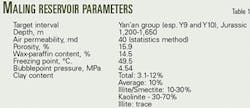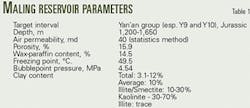Alternative-orientation hydraulic refracturing successfully stimulated low-permeability reservoirs in the Maling oil field, China.
The treatments involved creating a new fracture azimuth by directionally perforating and plugging of existed fractures.
Analysis indicted that some reasons for the low oil-production rate prior to the retreatment of the wells included closure of the initial hydraulic fractures, reservoir sensitivity to water, wax and paraffin deposition, and scale buildup.
Maling oil field
Maling oil field is a low-permeability sandstone reservoir. The target formation for the refracting is the Jurassic Yan'an group. Table 1 lists the reservoir parameters.1
Initial field development was in the 1970s and included hydraulic fracturing. Three subsequent redevelopment schemes during the past 30 years kept production stable until the 1980s. Production began to decline in 1985.
Most wells in the field produced at a low oil rate with a high water cut.
Analyses of the reservoir, fluid characteristics, and production performance indicated that the factors reducing oil production rate in Maling were:
•Closure of hydraulic fractures. Prior to production, most Maling well completions were fractured hydraulically. These fractures gradually have failed.
During production, pore pressure decreased and closure stress on the surface of propped fracture increased, probably causing the proppant to break. In addition, hydraulic fracture width decreased because of proppant deformation.
•Water sensitivity. Table 2 shows the clay mineral content in Maling. Core flow tests indicate that the reservoir is water sensitive. Average formation permeability decreased by 18.5% after waterflooding and was less than 77% of the permeability calculated from initial well tests. Formation damage increased as water cut increased.
•Scales and wax-paraffin deposit. The formation water contains Ca2++, HCO3–, and probably produced CaCO3 scale as the formation pressure gradually decreased during production operations. Also CaSO4 and BaSO4 precipitate out because of the incompatibility between formation and produced waters or degasification.
The scales precipitate and accumulate in the formation near the wellbore or in the tubing.
The reservoir has a high 14.5% wax-paraffin content, which also results in deposits in the formation because of the low reservoir temperature.
•Relative permeability. With increasing water saturation in the field, water productivity increased because of the higher water relative permeability, and oil productivity decreased because of the lower oil relative permeability.
Refracturing technology
After studying the technique, Maling field operators selected alternative orientation hydraulic refracturing to increase the oil rate and decrease water production.
In this technique the first step is to pump a plugging agent into a well. The agent selectively enters into and plugs existed fractures. In the next step, one induces new hydraulic fractures in a new azimuth, thus allowing more oil and less water production.
The hydraulic fracture azimuth always depends on the principal stress during stimulation and restimulation treatment.
Theoretical analysis and field tests prove that refracturing can induce a new fracture direction by altering the stress field.
For example, in Lost Hills field, in Kern County, Calif., initial fracture orientation was about north 55° east, but it changed to north 85° east during refracturing.
Alternative orientation refracturing was possible in Maling after the calculation of the in situ stress from hydraulic-fracturing treatment parameters and induced stress due to propped fractures.
The plugging agent in hydraulic refracturing should have the following behavior:
The agent should invade only the fractures and not the matrix, effectively plugging the fractures and keeping the matrix pores open.
The agent should have high strength and good visco-elasticity. This guarantees that the job induces the new fracture at a different orientation from the original fracture.
The agent should shear easily, so that it readily can be pumped and flowed.
The selected plugging agent, based on experiments, was XN-PG. Table 2 lists its main properties.
The fracturing fluid was water-based and contained a modified guar as a densifier, organic boron as a crosslinker, persulfate as a gel breaker, and other additives. The fluid properties were as follows:
- Density: 1,000 kg/cu m.
- Consistency coefficient: 2,490 MPa-sec.
- Flow index: 0.41.
- Spurt: 0.0.
- Leakoff coefficient: 6.53E-4 m/m1/2.
The fluid included a quartz proppant because of the low closure pressure in Maling. Table 3 lists the fracture conductivity.
3D geometry simulator
Fracture geometry depends on reservoir conditions, fracturing material properties (especially fracturing fluid behavior), and treatment parameters.
An optimal restimulation design requires a complicated process. For example, one determines the fracture geometry from fracturing fluid behavior that changes with temperature effects caused by heat transfer between the fracturing fluid, reservoir, and well formation fluid.
To evaluate these effects, the work included the use of a fracture geometry 3D simulator that included a temperature field of the borehole and fracture.3 4
Based on the principle of mass conversation, injected fluid volume is equal to the sum of fracture volume and total leak-off volume.
Pressure drop when fluid flows though the fracture was based on a simplified fracture cross section of an ellipse.3
Fracture width was calculated when a tension is exerted on the fracture wall.5 6
For an open-type fracture propagation criterion, the fracture height equation was based of a net pressure distribution.7
Refracturing case study
Well NB65 was completed at a 1,523 m depth in August 1994. It was hydraulically fractured in September 1994. Cumulative oil and water production to October 1997 were 917 tonnes and 3,444 cu m, respectively.
In April 1998, oil and liquid production were 0.17 tonnes/day and 1.07 cu m/day, respectively. Water cut was 81.3%.
Logging and producing performance indicated the probable existence of a water layer above the producing formation. The refracturing job design, therefore, included a low injection rate and an additive to contain the fracture height.8
After refracturing in April 1998, oil and liquid increased to 4.27 tonnes/day and 13.17 cu m/day, respectively. Water-cut dropped to 61.8%. Fig. 1 illustrates the production performance.
Acknowledgments
The authors thank Changqing Petroleum Exploration Bureau for providing the data, Pu Wanfen and Wu Xiaoling for their help during the experiments, and the National Key of Exploration and Exploitation of PRC for financial support of this research project.
References
- "The technique for keeping production rate in Maling Oilfield during high water-cut," CNPC, Changqing Petroleum Administration, 1991.
- Wright, C.A., and Steward, D.W., "Reorientation of Popped Refracturing Treatments in the Lost Hill Field," Paper No. SPE 27896, Western Regional Meeting, Long Beach, Calif., Mar. 23-25, 1994.
- Li Ping, and Wang Hongxun, "Numerical simulation for well bore temperature in hydraulic fracturing." ACTA Petrolei Sinica, No. 2, 1987.
- Li Ping, "Numerical simulation of temperature in hydraulic fracture," Natural Gas Industry, No.1, 1991.
- Hu Yongquan and Zhao Jinzhou, Principle and method of hydraulic fracture, Nanchong, China, 1999.
- England, A.H., and Green, A.E., "Some two-dimensional punch and crack problems in classical elasticity," Proceedings of Cambridge Philosophical Society, Vol. 59, 1963, p. 489.
- Hu Yongquan, "Numerical simulation for three dimensional fracture propagation in hydraulic fracturing," MS thesis, 1988.
- Nguyen, H.X., and Larsen, D.B, "Fracture height containment by creating an artificial barrier with a new additives," Paper No. SPE 12061, 58th SPE Annual Technical Conference and Exhibition, San Francisco, Oct. 5-8, 1983.
The authors
Hu Yongquan is an associate professor at Southwest Petroleum Institute, Nanchong, China. He is involved in conducting research on stimulation and production. Hu holds a BS and an MS in petroleum engineering from Southwest Petroleum Institute.
Zhao Jinzhou is a professor at Southwest Petroleum Institute. His research focuses on stimulation and production. Zhao holds a BS and MS in petroleum engineering from Southwest Petroleum Institute.
Peng Huiqun is a senior geologist-petrologist with the Changqing Petroleum Exploration Bureau, SINOPEC. Peng graduated with a BS in geology from the Jianghan Petroleum Institute.
Xu Shuhan is a senior engineer with Zhongyuan Petroleum Exploration Bureau, SINOPEC. He conducts research on production and management. Xu graduated from Southwest Petroleum Institute with a BS petroleum engineering.









